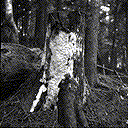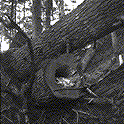Archived Content
Information identified as archived on the Web is for reference, research or recordkeeping purposes. It has not been altered or updated after the date of archiving. Web pages that are archived on the Web are not subject to the Government of Canada Web Standards. As per the Communications Policy of the Government of Canada, you can request alternate formats on the Contact Us page.
Stringy Butt Rot
Perenniporia subacida (Peck) Donk
(= Poria subacida (Peck) Sacc.)
Basidiomycotina, Aphyllophorales, Polyporaceae
Hosts: Perenniporia subacida is found in a wide range of coniferous and deciduous hosts. In B.C., it has been reported on amabilis, grand, and subalpine fir, tamarack, Engelmann, white, and Sitka spruce, lodgepole, Scots, and western white pine, Douglas-fir, western redcedar, western hemlock, maple, alder, arbutus, birch, cherry, cottonwood, and willow. Elsewhere in North America it has also been found on mountain hemlock, western larch, juniper, chestnut, tulip-tree, and cypress.
Distribution: This fungus is widely distributed throughout the range of its hosts in B.C.
Identification: The fruiting bodies are perennial, resupinate, and leathery to crust-like (Fig. 17a). The exposed surface is cream to light yellow and poroid; the pores are circular in outline, 5-6 per mm. Fruiting bodies may form on living trees, especially western redcedar, but are generally found on the underside of decayed logs or on the lower stem of dead-standing trees.
The early stage of decay appears as a light brown stain. Later, small white pits develop and coalesce to form a mass of white spongy fibres containing small, black flecks (Fig. 17b). Annual rings may separate to form a laminate decay; yellow-white mycelial mats frequently form between the sheets. The yellow colour of mycelial mats is relatively unique to this fungus. In the final stage, the wood is completely destroyed, leaving a hollow butt (Fig. 17c).
Microscopic Characteristics: Hyphae in the context of the fruiting body thin-walled with clamp connections. Basidiospores ovoid to broadly ellipsoid, hyaline, thin-walled, smooth, IKI-, 4.5-7.5 x 3-5 µm. Growth in culture moderately rapid, mat white, laccase positive, fibre hyphae common. Stalpers: 1 3 (6) (7) (11) (13) (14) 17 19 21 22 24 25 30 37 39 42 44 45 46 (47) 50 51 52 53 54 78 (80) 83 (88) (89) 90.
Damage: The presence of fruiting bodies on living trees indicates up to 3-4 m of defect; on dead trees fruiting bodies indicate almost total cull.
Remarks: Root and butt decay caused by P. subacida can cause significant losses and predispose infected trees to wind throw.
References:
Gilbertson, R. L. and L. Ryvarden. 1987. North American Polypores. 2:531. Fungiflora, Oslo.
Figures
Click on any image to see the full size version.
Press "Back" on your browser to return to this screen.

Figure 17a: P. subacida sporophore on western redcedar.
 Figure 17b: Advanced decay with mycelial mats caused by P. subacida.
Figure 17b: Advanced decay with mycelial mats caused by P. subacida.
 Figure 17c: Advanced decay with mycelial mats caused by P. subacida.
Figure 17c: Advanced decay with mycelial mats caused by P. subacida.
 This Web page has been archived on the Web.
This Web page has been archived on the Web.